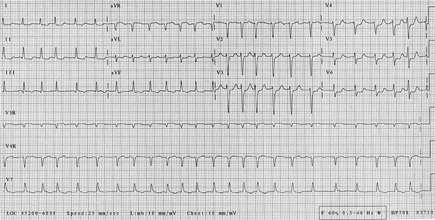EHRs' advantages may carry malpractice risks as well
Electronic health records have numerous advantages but also some potential pitfalls, as design flaws, complex templates and structured progress notes may lead to more complexity and more challenges to defense against malpractice.
While electronic health records are intended to improve record keeping and data communication in health care, some legal experts warn that they also may present novel malpractice risks for physicians.
“Physicians tend to perhaps over-rely on the fact that [EHRs] are automated. But an automated report can get garbled in translation,” said Jonathan P. Tomes JD, a Kansas health law attorney who consults with practices on EHR rules and implementation. “Most people think that electronic health records will cut down on malpractice, but it's not the [magic bullet] that people think it is.”
The U.S. Department of Health and Human Services announced in May 2013 that more than half of all doctors and eligible clinicians had received Medicare or Medicaid incentive payments for adopting or meaningfully using EHRs. Usage by eligible professionals grew by 33% from 2008 to 2012, the agency said in a press release.
“It's one of those trains where it's going faster than probably all of us can cope with, but whether you're the passenger who opted to get on or you were thrown on the train, we have to hold on tight because we have no choice [but] to be here,” said Alisa L. Chestler, a Washington, D.C.-based health law attorney at Baker, Donelson, Bearman, Caldwell & Berkowitz. She co-wrote a 2013 American Health Lawyers Association report titled “Minimizing EHR-Related Serious Safety Events.”
New pitfalls emerge with such fast-moving technology, Ms. Chestler said. Design flaws, complex templates, and careless usage by health professionals are all factors that can fuel EHR-related lawsuits and contribute to challenges defending claims.
Being mindful of the potential legal dangers of EHRs and taking steps to prevent them can save physicians significant time and expense, experts agreed.
Misuse and information overload
Potential legal dangers of EHRs often stem from the very processes meant to improve doctors' efficiency and enhance care, said P. Divya Parikh, director of research and risk management for Physician Insurers Association of America (PIAA), a national trade association for medical liability insurers.
“Because you have these structured progress notes now, it's making it difficult to decipher what is key information,” she said. “When there is note after note after note, some of the significant clinical information could possibly be lost in the dictation.”
Liability questions also arise when a physician does not access available electronic records and a poor outcome results, added Michael S. Barr, MD, MBA, FACP, senior vice president of ACP's division of practice management. Dr. Barr provides the example of an internist who fails to access a mammography report by another physician. The information may be in a broader network of health records, but not in the doctor's file.
“Is it my responsibility to go and pull it and put it in the report?” Dr. Barr said. “Could the internist be brought into a suit for delayed diagnosis? We don't know. This is all new territory.”
Another double-edged sword of EHRs is the copy-and-paste function, Ms. Chestler said. While moving patient notes and sections from other records around is quick and helpful, it can also lead to missed care details and repetition of incorrect data in the record, she said.
The plethora of clinical decision support and drug interaction alerts, warnings and reminders present their own legal snares for physicians, said David B. Troxel, MD, medical director for The Doctors Company, a national physician medical liability insurer. (ACP has exclusively sponsored The Doctors Company's medical malpractice insurance program since 2001.) Clinical decision support (CDS) alerts are meant to warn physicians when their orders deviate from a CDS guideline for chronic disease or medication management, he said, but doctors may override the alerts for various reasons.
“It may be appropriate to deviate from a CDS guideline and override a CDS alert in many clinical situations, but what doctors may not know is that the electronic health record will document that they overrode the alert,” he said. “If by overriding it an adverse event occurs, they may have to justify the alert override, which will be discovered when the plaintiff's attorney gets a copy of the electronic health record in native format.”
If physicians ignore an alert, they should ensure that the reason for the override is clearly explained and documented in the EHR, Dr. Troxel said.
Jury out on EHR legal impact
Few studies have analyzed the legal impact of EHRs, said Steven R. Simon, MD, MPH, FACP, chief of general internal medicine in the VA Boston Healthcare System and associate professor in the department of medicine at Harvard Medical School in Boston.
Dr. Simon and colleagues published 2 studies in Archives of Internal Medicine in 2008 and 2012 to help remedy the lack of research. The studies compared EHR use and reported paid malpractice claims in Massachusetts. While the 2008 results were only suggestive, the 2012 study found that use of EHRs was associated with a lower rate of malpractice claims.
Of 189 physicians surveyed in both 2005 and 2007, 14.3% were named in at least 1 malpractice claim. Of the 51 unique claims, 49 occurred before EHR adoption and 2 were related to events after EHR adoption, the study found.
“The one thing that was surprising was the magnitude,” Dr. Simon said. “We had a feeling we would see a lower rate of malpractice, but to see such a dramatic effect really convinced us to get the message out. It was clear evidence that EHRs probably lower medical malpractice rates but certainly do not increase them.”
The high quality and availability of proper documentation in EHRs may actually increase the likelihood of successful defense against malpractice claims, study authors said.
However, medical liability insurers say it's too early to know the exact effect of EHRs on litigation.
“There's a lag in time of several years between the occurrence of an adverse event and when a claim is filed so EHR-related claims have not yet been seen in significant numbers,” Dr. Troxel said. “These claims are probably going to start being seen in the next year or two. We're closely monitoring EHR risks.”
Dealing with design flaws
Other possible litigation dangers for physicians result from features out of physicians' direct control.
For example, many EHRs are template-driven, compelling doctors to enter information through a series of drop-down boxes or lists, Dr. Barr said. Some rigid structures and interface issues can prevent doctors from telling the patient's story accurately, he said.
One of the biggest design problems with EHRs is the inability of one organization's system to communicate with another organization's EHR, said Virginia L. Hood, MBBS, MPH, MACP, a past president of ACP.
“Our patients get care in different places,” she said. “All the information from the different sites is not necessarily available to a physician at the point of care when it is really needed to make good decisions for the patient.”
Dr. Hood said she has not personally heard of litigation resulting from EHR design flaws, but she has encountered patients who have identified incorrect information in their records.
“I have heard patients who were looking at information in their record say, ‘This isn't correct. That X-ray report said I had a procedure done, but I never had that procedure,’” she said. “Such inaccuracies written into electronic health records do have implications for patients. I would say it's a concern.”
Navigating unchartered legal waters
Addressing usability issues before they create legal problems is the first step to successful EHR implementation, legal experts said.
Mr. Tomes recommends researching vendors and choosing several finalists to interview before purchasing a system. It's important to ensure that the system's features match the practice's needs before buying it, he said.
Whether practicing in a small office or a large hospital, physicians should always make sure to be part of the EHR process, Dr. Barr stressed.
“Get involved in the committees or user groups that are involved with the EHR in your health system,” he said. “Don't be passive about it. Go ahead and contribute to the conversation, about the good things and about the things that might raise the patient care risk.”
In addition, closely examine vendor contracts to ensure you are not indemnifying the EHR company in the event of an EHR-related lawsuit, Dr. Troxel said. Many EHR contracts have clauses that relieve EHR vendors from liability should an adverse event result from a software failure or inappropriate clinical decision support guideline, so it is important to read all EHR contracts carefully.
EHR training for all staff members who will interact with the records is also key, Ms. Chestler said. This includes training for everyone who could access the record in any way, she said.
Legal experts stressed that with proper awareness, effort, and mitigation, doctors can reduce their legal risks and ensure their EHR is beneficial rather than harmful to their practice.
“Just like any change in the world we live in, there is a balance between the pros and cons,” Ms. Chestler said. “I would not say that one side dominates the other when it comes to weighing the benefits and detriments [of EHRs]. I would instead be more focused on enhancing the benefits for the provider while working to minimize any potential risks, thereby tipping the balance toward the positive.”




